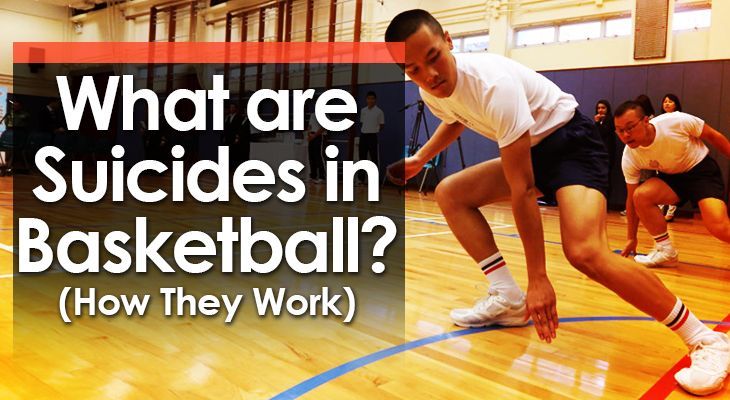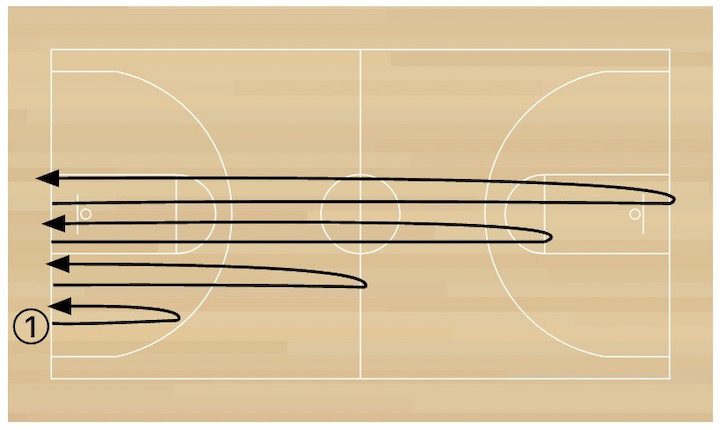
When it comes to conditioning, there are many ways coaches try to get their team in shape.
"Suicides" is a fitness drill used by basketball coaches across the world.
But what exactly are suicides?
And are they an effective way to condition your basketball team?
Let's discuss...
What are "Suicides" in Basketball?
"Suicides" is a conditioning drill that involves sprinting different lengths of the court.
The coach will have all players set up on the baseline and then they'll sprint to the following lines, making sure to return to the baseline after each touch:
- Nearest free throw line
- Half-way line
- Furthest free throw line
- Opposite baseline
Here's what one full repetition looks like:

(Obviously the player will stay in the same "lane" throughout the drill... I've just spread out the movements to make the diagram easier to understand.)
"Suicides" Basketball Drill Instructions
1. Line up on the baseline
Whoever is performing the suicide will line up on the baseline.
Players should spread out evenly to prevent running into each other, as players will end up going in opposite directions throughout the drill.
2. Start on the whistle
The coach will blow their whistle and that will signal to everyone to start.
3. Sprint to the nearest free throw line
Players start the drill by sprinting to the free throw line closest to the baseline they started on.
To prevent cheating, players must TOUCH the free throw line (or FT line extended) with their hand or foot before running back to the baseline.
4. Sprint to the half court line
After touching the baseline, players then sprint to the half court line.
They’ll turn at the half court line and run back to the baseline where they started.
5. Sprint to the farthest free throw line
Players will then head back down the floor to the free throw line farthest from them.
This will be 3/4th of the way down the floor.
They will touch that line and once again return to the baseline they started on.
6. Sprint to the opposite baseline
For the final leg of the suicide, players will sprint down and touch the opposite baseline.
They will finish the suicide by returning back to the baseline in which they started.
That's one repetition.
Here's a video of the entire process:
Are Basketball Suicides Beneficial?
Coaches use suicides in practice for one of two reasons:
1. As a punishment
2. To get their team in shape
Let's discuss if these are legitimate reasons to run suicides, starting with...
#1 - Using Suicides as a Punishment
Many coaches will use suicides as a punishment for losing a drill or losing focus during practice.
It's more of a "consequence" than a punishment.
To me, there's nothing wrong with using suicides for this purpose.
Running "suicides" is a short but intense conditioning drill -- players don't enjoy them.
By making *running one suicide* a consequence for losing a competitive drill, this will provide players with extra motivation to work hard.
And because it only takes a minute to run one, it's not a waste of practice time.
#2 - Using Suicides for Conditioning
Some coaches use "suicides" as one of their conditioning drills to improve fitness.
To me, this is NOT a good idea for most teams.
"Why?"
As discussed in my article on eliminating "running for fitness" from basketball practices, there are many downsides to spending too much time on non-basketball conditioning drills.
- Doesn't develop basketball skills
- Players don't enjoy them
- Waste of practice time
I'd only consider using suicides as a conditioning drill at the high school level and up.
I would NOT recommend using suicides for conditioning at the youth basketball level.
How to Improve Conditioning Without Suicides
The best alternative is to use high-intensity, full court basketball drills.
This allows players to work on their basketball skills and fitness at the same time.
Check out our full collection of basketball drills for ideas.
Frequently Asked Questions (FAQ)
How Many Suicides are in a Mile?
High School Courts:
Most junior high and high school basketball courts are 84 feet.
- A sprint to the nearest free throw line and back is 30 feet.
- A sprint to the half court line and back is 84 feet.
- A sprint to the farthest free throw line and back is 138 feet.
- A sprint to the opposite baseline and back is 168 feet.
The total number of feet ran is 420.
A mile is 5,280 feet.
If you divide 5,280 by 420, it is 12.57.
It would take just under 13 suicides to run a mile on a high school court.
Professional and College Courts
Most professional and college courts are 94 feet.
(10 feet longer than junior high and high school courts.)
- A sprint to the nearest free throw line and back is 30 feet.
- A sprint to the half court line and back is 94 feet
- A sprint to the farthest free throw line and back is 158 feet
- A sprint to the opposite baseline and back is 188 feet.
The total number of feet ran is 470.
If you divide 5,280 by 470, it is 11.23.
It would take just over 11 suicides on a college or professional court to equal a mile.
Conclusion
Suicides are a conditioning drill used by many basketball coaches.
They are high intensity and involve running up and down the basketball court.
While they can be an effective conditioning drill, it’s best to work fitness within your drills.
